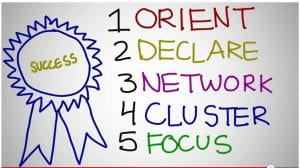Hello Everyone –
What happens when … we open the doors of our virtual classrooms? … students create the tools with which they learn? … learners leverage the power of resources that are openly licensed? … learn from and engage with social networks of other educators who are committed to open learning? Over the next eight weeks we will explore these fundamental questions and also experiment with open learning practices.
 Dave Cormier outlines five phases for an open, connected approach to learning (listed to the right). I would add a sixth phase to his list: celebrate. This extended version of Cormier’s schema serves as the structure of our class.
Dave Cormier outlines five phases for an open, connected approach to learning (listed to the right). I would add a sixth phase to his list: celebrate. This extended version of Cormier’s schema serves as the structure of our class.
In Week One you will orient yourself to the original motivation for open learning, the shared vision held by people who founded the concept, and recent hot debates.
In Week Two you will sift through the work that has gone before you, the history of open learning, to define the concept for yourself. You will declare the relevance of open learning for your work as an education professional. This process will also help you clarify your fundamental beliefs regarding the purpose of education.
In Week Three we will pool our energies to network and gather a rich collection of resources you can draw upon in your work. You’ll see what’s out there, evaluate the credibility and usability of sources, to separate the wheat from the chaff.
Somewhere between Week Three and Week Four you will distill and cluster your work around a theme that is important to you. This will become the topic for a mini-MOOC that you will develop for your signature assignment. For more on this assignment, see Assignments & Rubrics, located at the bottom of the page in the Modules area of this course .
In Week Five you will focus your energies. You’ve immersed yourself in open education resources that are related to your topic and done some planning — now it’s time to create your own original contribution to the world of open learning!
In Weeks Six and Seven the tables will turn. You’ll have an opportunity to serve as a catalyst for open learning, mobilizing a sea of open resources to author a Mini-MOOC that you will share with the rest of the class.You’ll teach your mini-MOOC and also participate as a student in your peers’ courses.
In Week Eight we will view your masterpieces and celebrate your accomplishments!
My hope is that your experience in this course will help you connect with the “big ideas” that are associated with Open Learning, collaborate to uncover and evaluate a rich trove of resources that are important to you in your work and life, and create new offerings you are proud of so that you can pay if forward in the field of Open Learning.
Best –
Gail
Image Source: http://davecormier.com/edblog/2013/12/29/unravelling-a-model-for-an-open-course/
